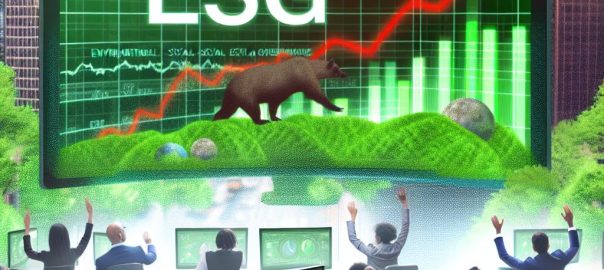The Evolution of ESG Investing
In recent years, there has been a significant surge in interest in Environmental, Social, and Governance (ESG) investing. Investors are increasingly looking beyond traditional financial metrics to evaluate the impact of their investments on society and the environment. This shift has been driven by a growing recognition of the importance of sustainable and responsible investing. As a result, ESG-focused investment vehicles have gained traction, with ESG Exchange-Traded Funds (ETFs) emerging as a popular choice among various options available in the market. This article explores the evolution, components, and future of ESG investing, with an emphasis on understanding the role of ESG ETFs in this landscape.
Understanding ESG ETFs
Exchange-Traded Funds (ETFs) are investment funds traded on stock exchanges, much like stocks. They hold assets such as stocks, commodities, or bonds and generally operate with an arbitrage mechanism designed to keep trading close to its net asset value. ESG ETFs specifically focus on companies with strong environmental, social, and governance practices. These funds aim to provide investors with exposure to businesses that meet specific ESG criteria, enabling investors to align their portfolios with their values while maintaining financial performance. As the appeal for ESG grows, these ETFs cater to a diverse range of investors seeking to balance profitability with principles.
Reasons Behind the Rise
Several factors contribute to the increasing prevalence of ESG ETFs. One of the primary drivers is the growing awareness and concern among investors about environmental issues such as climate change and resource scarcity. Sustainability is no longer just a buzzword; it has become a crucial consideration in investment strategies that aim for long-term viability as opposed to short-term profit.
Moreover, social issues such as labor practices, diversity, and corporate governance are gaining more attention than ever before. Investors are keen on supporting companies that demonstrate strong social responsibility and ethical governance practices. This shift in priorities is encouraging companies to improve their ESG performance, which in turn attracts more investment into ESG-focused funds. Businesses are beginning to realize that solid ESG practices can be a source of competitive advantage, attracting both investors and customers who are more inclined to support companies with values aligned to theirs.
The Role of Regulation and Policy
Government policies and regulations have played a critical role in promoting the rise of ESG investing. As governments worldwide introduce legislation aimed at encouraging sustainable business practices and discouraging harmful ones, companies are compelled to adapt to this new landscape. This creates further opportunities for ESG ETFs to capitalize on these transitions, by directing funds towards companies compliant with new regulations and whose practices meet the heightened expectations of responsible investing.
Additionally, large institutional investors are increasingly incorporating ESG criteria into their investment decisions. This trend is driven by both regulatory requirements and the growing demand for transparency and accountability from stakeholders. Incorporating ESG criteria is becoming not just a recommendation but is increasingly seen as a necessity for institutional investors who manage significant amounts of public funds.
Challenges and Considerations
Despite their growing popularity, ESG ETFs face several challenges that need to be addressed. A significant issue is the lack of uniformity in ESG criteria and ratings. Different rating agencies may evaluate ESG factors differently, leading to potential discrepancies and making it challenging for investors to compare ESG scores across companies or funds. This inconsistency can create uncertainty for investors looking to ensure their investments meet specific ESG standards.
Another challenge is the risk of greenwashing, where companies might overstate their sustainability credentials to attract investors. Consequently, investors must exercise due diligence when selecting ESG ETFs, ensuring that the funds they choose truly align with their sustainability goals. The prevalence of greenwashing highlights the need for more robust and regulatory-compliant methods to declare and verify ESG credentials for increased investor confidence.
The Role of Technology and Data
The advancements in technology and data analytics are gradually transforming the landscape of ESG investing. Enhanced data collection and analysis capabilities enable more precise evaluation and reporting of ESG metrics. Machine learning and artificial intelligence techniques help in processing vast amounts of data to identify patterns and trends within the ESG domain. This advancement provides investors with more reliable and consistent data, which is crucial for mitigating some of the existing challenges in ESG integration, such as inconsistency in ratings and the risk of greenwashing.
The Future of ESG ETFs
As awareness and demand for responsible investing continue to grow, ESG ETFs will likely remain an integral part of the investment landscape. Innovations in data analytics and increased transparency are expected to further improve the evaluation and reporting of ESG metrics. This growing improvement in ESG reporting standards will empower investors to make more informed decisions by providing a clearer picture of a company’s performance against various ESG criteria.
In conclusion, the rise of ESG ETFs marks a significant shift in how investors approach their portfolios, reflecting a broader philosophical shift about the purpose of investing beyond mere profit. By prioritizing environmental, social, and governance factors, ESG ETFs offer an opportunity to invest responsibly while aiming for competitive financial returns. As the market evolves and integrates more sophisticated analytical tools, these funds are poised to play an increasingly prominent role in the future of investing, paving the way for a more sustainable financial ecosystem.
This article was last updated on: July 11, 2025

